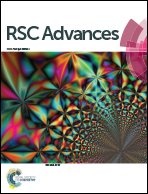Simultaneous enhancement of Raman scattering and fluorescence emission on graphene quantum dot-spiky magnetoplasmonic supra-particle composite films†
Abstract
Graphene quantum dots (GQDs) are a new type of quantum dot that have low cytotoxicity, excellent solubility, chemical inertia, and stable photoluminescence and Raman signal, and are promising materials for various applications. Due to their Raman scattering (RS)-fluorescence emission (FE) multi-mode optical property, GQDs have been considered as an important candidate for applications in photovoltaics, light-emitting devices, bioimaging and diagnostic techniques. However, GQD-related applications are severely restricted because of the high signal attenuation, low contrast, and low resolution. To overcome these problems, we have designed a reliable strategy for enhancing the RS-FE of GQDs to make them suitably efficient for their applications. In this study, we utilized spiky Au-coated Fe3O4 supraparticles (Fe3O4@Au SPs) to enhance the RS-FE of the GQDs by fabricating layer-by-layer (LbL) assembled GQD-spiky Fe3O4@Au SPs composite films. The RS and FE enhancements of 13-fold and 7.8-fold, respectively, were observed for the GQD-spiky Fe3O4@Au SPs composite films. It is also proved that external magnetic fields have an attenuation effect on the Raman activity of spiky Fe3O4@Au SPs. Moreover, the GQD-spiky Fe3O4@Au SPs composite films exhibited remarkable multi-mode imaging capabilities for Raman mapping and fluorescence imaging, which are expected to find application in photonic devices.


 Please wait while we load your content...
Please wait while we load your content...